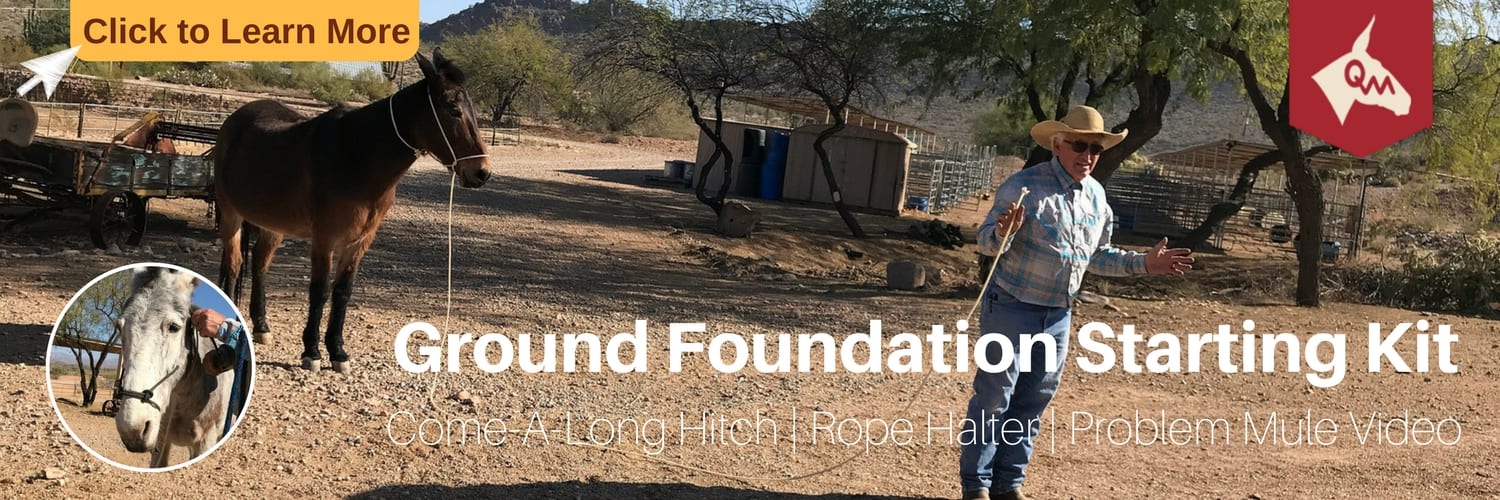Training A Mule – Don’t Create An “Ass From Hell”
I recently received a letter from a man who has a couple of young mules. I must first commend him on asking for help. But then I have to get really firm with him, because he is making some strategic mistakes that can jeopardize his safety. Let me begin by paraphrasing his issues.
Understanding Your Mule’s Behavior
We’ll call the writer “Fred” to protect his confidentiality. Fred wrote that he and his family were offering his mule some apples when the mule bit him. Apparently, the mule has done this with others as well. and they’re complaining that the bites are painful. He asked how floating the teeth fits into this situation, if at all, and then asked a bit about general behavior. He reports that the mule is leaning into him and pushing him around.
Where to start? I think for safety’s sake, we have to begin with the mule respecting the owner’s space. I can tell you a story from my days at Pierce College when some of my students were watching a hundred-pound, petite lady fight with her 17-hand Shire horse at a show. She was being tossed around like a rag doll in the midst of a busy venue. She had a chain on the horse, but it was not effective at all. I could see that disaster was just around the corner. There were lots of people around, kids running, babies in strollers, etc. So, I asked one of my students to fetch my Come-A-Long rope. In the meantime, I asked the woman if I could be of assistance and she was happy to hand her horse over to me.
Show Your Mule or Donkey Who Is In Control
Once I had the Come-A-Long in place, I was able to control the horse’s feet in a matter of a few minutes, meaning he learned to stand still. I am a firm believer that the equine should stand still at a safe distance. But this carries with it the responsibility of the owner to stay a safe distance away from the mule. When people run up too close to the mule or horse, their natural instincts will kick in.
Remember, mules have a fight or flight response. If you move in too quickly or with a posture that makes the mule question your motives, he will either take off OR he will push back. Neither is desirable. In using the Come-A-Long rope, our goal is to establish that we control the mule’s feet and will have a safe buffer space between us at all times. No questions asked.
Now to do this, nobody has to be mean to the animal. Trust me when I tell you that the mule is grateful to have a responsible, consistent and fair leader. You must set the rules and you must follow them religiously. The mule cannot live in a world where sometimes you do it one way and sometimes you do it another way because you are tired, want to hug him or whatever. He wants black and white. He wants to know exactly where he stands.
Establishing Leadership With Your Mule Or Donkey
Using the Come-A-Long allows me to draw a clear line between comfortable and uncomfortable for the equine. Do what I ask and there is no pressure on your precious nose. But give me attitude or move in a way that is not acceptable and your nose will suffer the consequences. It’s that simple and direct. Mr. Mule will always opt for comfort when given the choice between comfortable and uncomfortable.
First and foremost, communication with your mule begins with establishing that you are the leader. You say when and how he can move. And you say how far away from you he must stand. Sometimes, I even kick a little dirt at a mule who is thinking about encroaching on my space. It’s a gentle “reminder.” I have a DVD about communication with your mule that goes into this in more detail.
Should You Give Your Mule Or Donkey Treats?
Now, let’s talk about the treat situation. The woman that I mentioned above told me how she loved to give her horse carrots. The problem was that one time she reached up to pet his nose and he thought her finger was a carrot. She now has half an index finger where he bit it off. The crushing power of a horse’s or mule’s jaw is intense. Our little body parts are no match.
Any behavior that encourages mouthing is totally unacceptable. The mule should have a quiet mouth at all times when in our vicinity or doing anything with us. Folks seem to always want to give treats to mules and horses – I cringe when I see it. They are not dogs. Training for a horse or mule does not need to involve a treat. The training itself is a reward and the treat does not reinforce the lesson. In fact, it may well undermine your good intentions by making the mule “demand” the treat; eventually Mr. Mule won’t perform the task without a treat. Remember, they are smart!
In the Grand Canyon, lots of people want to “treat” their mules. That is, until they get bit. There are huge signs telling people not to feed the mules, but people still get bit because they will offer grass or some goody on the sly. Mr. Mule will not look at you adoringly like your puppy does after he gets a good treat. Instead, he will either totally dismiss you when he sees you have no more OR he will get pushy and demand more. Neither is good. While we do control the food, it must be on our terms. We are not feed bags.
There are times when offering a treat does foster training and communication. But these times are limited and should be done only with a clear understanding of the goal. For example, if you can’t get a mule to approach you, you can entice him to come closer with a treat. But when he reaches a reasonable distance (3-4 feet from you), you should either drop the treat, so he can pick it up OR hold it out at full arms length in an open and flat hand, so he can’t grab your fingers.
Giving treats is a hot topic among equine trainers. Some insist that no treats should ever be given by hand. At the other extreme, some say that the equine should be trained to be gentle enough to take a treat from a child. I am somewhere in between, I guess. But generally, I am not a treat person; I think you can see why.
Treats Are Not Always The Best Solution
Before I get off the treat issue, I want to share one more story. I knew a lady who decided that if she gave her mule treats while she was preparing to mount, the animal would stand still enjoying the treat so she wouldn’t have to work so hard to teach her molly to stand still at the mounting block. This is trouble for a couple of reasons. First, you may have to mount when you don’t have a treat handy and the mule will surely make you pay for that mistake. Secondly, her mule learned to wolf that treat down pretty quickly and would “beat her to the punch” – the treat would be gone, the woman would be half on and the mule would be dancing around looking for another treat.
The Health of Your Mule’s Or Donkey’s Teeth Matter
Fred asked about floating teeth and if that led to the biting behavior. Floating the teeth has nothing to do with biting behaviors. It does influence how well the mule tolerates a bit. Now teeth do play an important role in behavior and the overall health of the animal. Abscessed or broken teeth or teeth with sharp points will cause the mule to have difficulty eating and may lead to him giving you trouble. Floating the teeth of the young mule that Fred described would not solve his biting problem; though he should have the vet check Ole’ Fluffy’s teeth routinely when he comes for annual shots.
Ask, Tell, Demand
Through all of this, I want Fred to understand that all interactions with his mules follow the Ask, Tell, Demand pattern. This is the same between animals in the pasture. Either you or the mule are going to be herd leader. It’s up to us to make sure it’s not Mr. Mule. Here’s how it goes among the equines themselves.
ASK – The lead mare pins her ears and asks Mr. Mule to get out of her space.
TELL – The mule does not get out of her space. The lead mare then pins her ears and swishes her tail.
DEMAND – The mule keeps coming, so now the lead mare spins and kicks. If she connects, that generally gets the job done.
The fact is Mr. Mule will use his body to communicate with you. If he can push into you and make you move out of his way, he is herd leader. If you don’t allow him into your space (ask, tell, demand) and you insist that he is the one not moving his feet, you are herd leader. That is not being mean.
Owning a mule or donkey is not a democracy. For everyone who thinks that they should offer the mule choices or give him breaks for good behavior – you are actually causing the mule to be more uncomfortable. He likes direction, black and white, and ease. He is inherently lazy and if you are a good herd leader, he knows you will take care of him and he will not test you. But plant that seed of doubt and he starts thinking, “Oh my! I better take control here.”
How To Treat Feeding Time
Other behaviors often revolve around feeding time. I was helping some folks who had Percherons that were causing some pretty big injuries, like broken toes. It seems that the folks were bringing out buckets of feed and the horses were charging in and being very physical in order to grab the grain. Thinking this through should lead you to preparing feed in a separate area and then allowing the horses access to a trough or bucket. A human holding food is nothing more than a target for an equine who wants that grub.
Your Next Steps
Phew! I have covered a lot of ground in answer to Fred’s questions – but I want to save him a trip to the emergency room and I want him to avoid creating the Ass from Hell. He is doing no favors for his mules or himself by continuing his current plan. My response to Fred is simply this.
- You have to be herd leader. You must be confident and consistent.
- You have to learn more about communication with your animals. They aren’t people and they aren’t dogs. Something like my Ground Foundation & Communication kit will help you establish that open and meaningful line of communication.
- Treats have no place in mule training. The mule may want them, but he does not “value” them. And if he can get treats from you on his terms, he is showing you how much smarter he is.
- You are not being unkind or mean by insisting that your mule keep a respectable distance from you and by insisting that he not “mouth” you or frisk you for treats. It’s all part of being the leader. The leader controls the food. The leader moves the feet. The leader controls behavior. That leader must be you
You will be surprised how much sweeter your mule becomes once he feels he can depend on you to look out for him. He likes structure and rules. He feels insecure and unsure of himself when he has to question what should be done.
Fred, you have started to make your mule an “ass from hell.” But the good news is that it’s not too late! Get that foundation kit and spend 4-6 hours a week for 30 days training your mule; you won’t believe how different your life with a youngster can be. Kudos to you for seeking advice – now it’s time to get to work!
- Posted in: Articles, Everything
- Tagged: Articles, Everything




5 thoughts on “Training A Mule – Don’t Create An “Ass From Hell””
I have started my mule under saddle and he is steering well at the trot , backing and walking over obstacles but has recently starting randomly turning to the right. He is very strong about this and won’t let go of the bit. I’ve tried spurs and a crop with some success. It he isn’t ready to give it up yet. Will my persistence eventually solve this problem?
Hi June, I have been experiencing the same problem. Today I made her just stand in the direction I wanted to go. She paused for a few minutes then waked out on her own. I had her out on my trails a dozen times, then the other day she started to turn in her own direction and the more I persisted the stronger she became. Also switched to a tom thumb bit,
It sounds to me like the mule is telling you that something is causing him pain. What are you using for a saddle, are you riding with a britching and a breast collar? Have his teeth been floated ? How are his hooves cared for, is he shod? What kind of Bit are you using? All these things can cause your mule to try and escape pain. Have you given him a proper ground foundation? Go to Queen valley mule ranch on youtube, there are many great videos there that may help you.
I have a 5 day old mule foal that has started kicking. He can be very pushy and mouthy, too.
I have him haltered. I have read that you should tie the foal because mules won’t hurt themselves. Should I tie him this young and what corrective measures can I use for the kicking and being mouthy.
It sounds to me like the mule is telling you that something is causing him pain. What are you using for a saddle, are you riding with a britching and a breast collar? Have his teeth been floated ? How are his hooves cared for, is he shod? What kind of Bit are you using? All these things can cause your mule to try and escape pain. Have you given him a proper ground foundation? Go to Queen valley mule ranch on youtube, there are many great videos there that may help you.